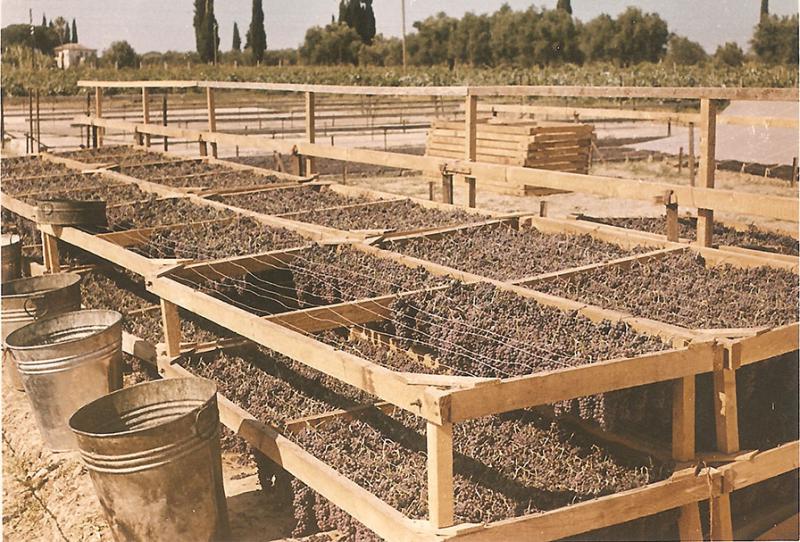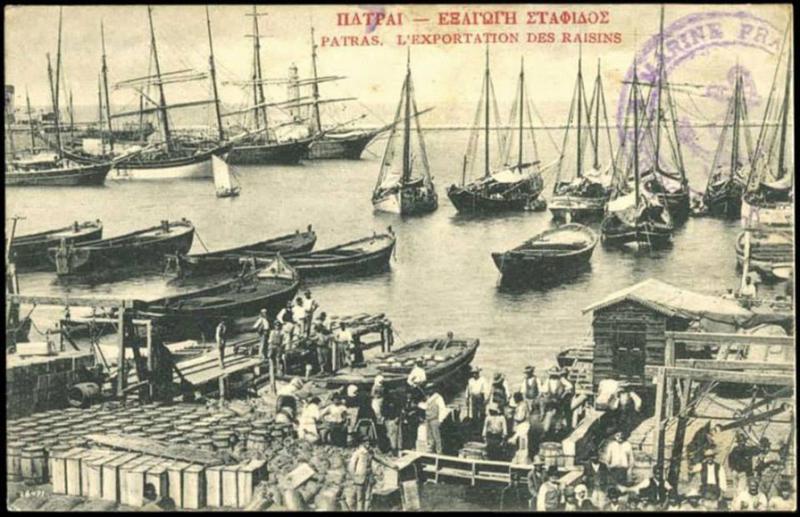Small, almost black-colored and highly aromatic, dried Corinth raisins (also known as currants) have always been extremely popular in Greece, to the extent that the country’s overproduction actually led to a full-blown crisis, over a century ago. Sweet raisin is not only delicious, but also extremely healthy. Hence it usually ends up either in muesli, or in several Greek desserts, including Christmas cookies.
Currant production in Corinth
Seedless and distinctive for their black color, currants are the dried grapes of a very specific pure Greek variety (Vitis Vinifera L). As the unique microclimate of the Peloponnese favors the cultivation of this unique fruit, they are grown almost exclusively in parts of Greece where winters are mild and summers are warm and rain is a rarity. Aigialeia, on the East of Patras, is a perfect example, known for its exceptional production of currants. The region’s North-facing vineyards are difficult to access, as they are protected from the hot African winds by the surrounding mountains.
Attempts to grow currants in different regions of the world, such as China, Uzbekistan and Australia, have also been made. Notably, in California, where the climate is quite similar to that of Greece, the currants’ flavor comes close to the one produced in Corinth. The special combination of fertile soil and mild climate in the South of Greece’s mainland, however, is what makes the small black raisin an elite seed.

Currant production requires meticulous care and endless dedication from producers all throughout the year. Unlike raisins, currants are not being sulfurized, and no preservatives are added. This results in a natural, high-quality production, without any additives. Harvesting takes place from August to September, when grapes dry naturally under the hot summer sun.
The origins of currants
What many do not know is that currants are non a Corinth-exclusive seed. On the contrary, they grow in several areas across the Peloponnese, including the regions of Achaia and Ilia, as well as the island of Kefalonia. The term “currant” derives from the Greek port city of Corinth, located between the Peloponnese and the Greek mainland, connected with an artificial canal. The region’s ports served as a point of shipment for dried grapes, hence the name.

Both the geographical indication (PGI) and designation of origin (PDO) of different varieties of currants are protected. Some of those are the currants from Aigialeia, known as “Corinthian Stafida Vostitsa”, and the currants produced on the island of Zakynthos, known as “Stafida Zakynthou”. “Stafida llias” from the Ilia region is protected on the grounds of its geographical indication.
Currant during times of prosperity
Many historical sources, including Homer’s celebrated work, cite that the renowned royal grape has accompanied the humankind for centuries. Our ancestors seem to have discovered it by chance while curiously tasting the last dried grapes on the vine, only for it to be later included in their diet.
“Currants are to Greece what coffee is to Brazil” opined economist Xenophon Zolotas. This is not an exaggeration, because the share of the raisin in the country’s overall export peaked at 50%, back in the 19th century. It may rightfully be referred to as Greek’s national product, as, even today, historical traces can be found that allow conclusions to be drawn about the important role of the currant in the Greek economy.
Thus, in the course of the 19th century, currant production infrastructure was expanded in order to deliver significantly large quantities all across Europe. Many ports were developed, while the Peloponnese peninsula became accessible by a network of railroads, and the famous Corinth Canal was constructed. Architectural masterpieces such as the Apollon Theater in Patras and other neoclassical buildings, as well as festivals, such as the unique carnival of Patras, date back to this era of prosperity.
Today, about 15,000 families make their living out of currant production. Nowadays, currant accounts for 2% of Greek agricultural exports. Currants are used mainly in desserts and pastries, and they have a firm place in Greek cuisine, especially in vegetarian dishes such as stuffed veggies. First-class brandies and vinegars are still made from low-quality currants.
Health benefits
Bursting with nutritious ingredients, and rich in antioxidants and polyphenols, a handful of currants can be a healthy snack in between meals. In fact, just 35 grams of raisins can replace one of the recommended five servings of fruits and vegetables a day.
Moreover, currants are the only type of raisin, the daily consumption of which is clinically proved to lower blood pressure, as well as cholesterol levels, thus providing protection against cardiovascular diseases. As strange as it may sound, the drying process and further processing of raisins does not affect their beneficial and antioxidant properties in any way.
Michael Karvelas
Our author comes from a family that has been producing currants for years. Michalis Karvelas studied chemistry in Thessaloniki, before completing his MBA studies, with a focus on marketing. Today, he works as a chemist and he is responsible for research and development at the Greek Currants Producers Association (SKOS) in Patras. He has dedicated his work to various initiatives to publicize the beneficial properties of currants.


